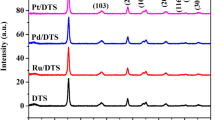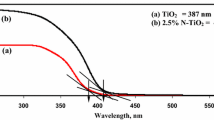Abstract
Simultaneous photocatalytic degradation of an aqueous mixture of methylene blue (MB) and rhodamine B (RhB) by anatase TiO2 catalyst under UV light irradiation was investigated. In the mixed solution, degradation rate and efficiency of MB (0.151 ± 0.013 min‒1, 92.3 ± 1.2%) was found to be much higher than for RhB (0.025 ± 0.003 min‒1, 20.5 ± 0.6%). This was in contrast to the degradation rate and efficiency of MB and RhB when they were in solution alone (0.173 ± 0.019 min‒1, 93.1 ± 1.1% and 0.115 ± 0.005 min‒1, 96.1 ± 1.2%). The domination of MB over RhB in the simultaneous photocatalysis was further confirmed by adding different molar fractions of each dye and using H2O2-assisted methods. These results can be explained by considering that the planar MB molecules have steric interactions inhibiting Coulombic attraction for RhB to the catalyst surface and suppressing its photocatalytic degradation efficiency. This paper provides an important insight into the governing factors during simultaneous photocatalytic removal of synthetic dyes during the treatment of multicomponent wastewater.







Similar content being viewed by others
References
Saini RD (2017) Textile organic dyes: polluting effects and elimination methods from textile waste water. Int J Chem Eng Res 9:121–136
Hagan E, Poulin J (2021) Statistics of the early synthetic dye industry. Herit Sci 9:33
Ardila-Leal LD, Poutou-Piñales RA, Pedroza-Rodríguez AM, Quevedo-Hidalgo BE (2021) A brief history of colour, the environmental impact of synthetic dyes and removal by using laccases. Molecules 26:3813
Forgacs E, Cserháti T, Oros G (2004) Removal of synthetic dyes from wastewaters: a review. Environ Int 30:953–971
Zazouli MA, Kalankesh LR (2017) Removal of precursors and disinfection by-products (DBPs) by membrane filtration from water; a review. J Environ Health Sci Eng 15:25
Gadekar MR, Ahammed MM (2020) Use of water treatment residuals for colour removal from real textile dye wastewater. Appl Water Sci 10:160
Wawrzkiewicz M, Hubicki Z (2015) Anion exchange resins as effective sorbents for removal of acid, reactive, and direct dyes from textile wastewaters. In: Kilislioglu A (ed) Ion exchange-studies and applications. IntechOpen. https://doi.org/10.5772/60952.
Zhang M-H, Dong H, Zhao L, Wang D-X, Meng D (2019) A review on Fenton process for organic wastewater treatment based onoptimization perspective. Sci Total Environ 670:110–121
Buscio V, Brosillon S, Mendret J, Crespi M, Gutiérrez-Bouzán C (2015) Photocatalytic membrane reactor for the removal of C.I. disperse red 73. Materials 8:3633–3647
Shahrin EWES, Narudin NAH, Padmosoedarso KM, Kusrini E, Mahadi AH, Shahri NNM, Usman A (2021) Pectin derived from pomelo pith as a superior adsorbent to remove toxic Acid Blue 25 from aqueous solution. Carbohydr Polym Technol Appl 2:100116
Arshadi M, Attard TM, Lukasik RM, Brncic M, da Costa Lopes AM, Finell M, Geladi P, Gerschenson LN, Gogus F, Herrero M et al (2016) Pre-treatment and extraction techniques for recovery of added value compounds from wastes throughout the agri-food chain. Green Chem 18:6160–6204
Wang JL, Xu LJ (2012) Advanced oxidation processes for wastewater treatment: formation of hydroxyl radical and application. Crit Rev Environ Sci Technol 42:251–325
Hisaindee S, Meetani MA, Rauf MA (2013) Application of LC-MS to the analysis of advanced oxidation process (AOP) degradation of dye products and reaction mechanisms. TrAC 49:31–44
Wang XQ, Han SF, Zhang QW, Zhang N, Zhao DD (2018) Photocatalytic oxidation degradation mechanism study of methylene blue dye waste water with GR/iTO2. MATEC Web Conf 238:03006
Javaid R, Qazi UY (2019) Catalytic oxidation process for the degradation of synthetic dyes: an overview. Int J Environ Res Public Health 16:2066
Phanichphant S, Nakaruk A, Chansaenpak K, Channei D (2019) Evaluating the photocatalytic efficiency of the BiVO4/rGO photocatalyst. Sci Rep 9:16091
Zhao S, Chen C, Ding J, Yang S, Zang Y, Ren N (2022) One-pot hydrothermal fabrication of BiVO4/Fe3O4/rGO composite photocatalyst for the simulated solar light-driven degradation of Rhodamine B. Front Environ Sci Eng 16:36
Chiu YH, Chang TFM, Chen CY, Sone M, Hsu YJ (2019) Mechanistic insights into photodegradation of organic dyes using heterostructure photocatalysts. Catalysts 9:430
Chanu LA, Singh KJ, Devi KN (2020) Study on the photocatalytic activity of metal oxide nanoparticles towards the degradation of some organic dyes. Integr Ferroelectr 204:90–99
Luttrell T, Halpegamage S, Tao J, Kramer A, Sutter E, Batzill M (2015) Why is anatase a better photocatalyst than rutile? -Model studies on epitaxial TiO2 films. Sci Rep 4:4043
Zulmajdi SLN, Zamri NII, Yasin HM, Kusrini E, Hobley J, Usman A (2020) Comparative study on the adsorption, kinetics, and thermodynamics of the photocatalytic degradation of six different synthetic dyes on TiO2 nanoparticles. React Kinet Mech Catal 129:519–534
Blažeka D, Car J, Klobučar N, Jurov A, Zavašnik J, Jagodar A, Kovačević E, Krstulović N (2020) Photodegradation of methylene blue and rhodamine B using laser-synthesized ZnO nanoparticles. Materials 13:4357
Yin X, Liu L, Ai F (2021) Enhanced photocatalytic degradation of methylene blue by WO3 nanoparticles under NIR light irradiation. Front Chem 9:683765
Alaei M, Mahjoub AR, Rashidi A (2012) Effect of WO3 nanoparticles on Congo red and rhodamine B photo degradation. Iran J Chem Chem Eng 31:23–29
Majumder D, Chakraborty I, Mandal K, Roy S (2019) Facet-dependent photodegradation of methylene blue using pristine CeO2 nanostructures. ACS Omega 4:4243–4251
Li P, Zhang W, Zhang X, Wang Z, Wang X, Ran S, Lv Y (2018) Synthesis, characterization, and photocatalytic properties of flower-like Mn-doped ceria. Mater Res 21:e20180167
Wang B, Guo L, He T (2016) Fabrication of an olive-like BiVO4 hierarchical architecture with enhanced visible-light photocatalytic activity. RSC Adv 6:30115–30124
Zhang L, Chen D, Jiao X (2006) Monoclinic structured BiVO4 nanosheets: hydrothermal preparation, formation mechanism, and coloristic and photocatalytic properties. J Phys Chem B 110:2668–2673
Wojtyła S, Baran T (2015) Semiconducting materials towards photocatalytic air treatment. materials, tests and practical application. Eur Chem Bull 4:260–267
Rochkind M, Pasternak S, Paz Y (2015) Using dyes for evaluating photocatalytic properties: a critical review. Molecules 20:88–110
Rani S, Aggarwal M, Kumar M, Sharma S, Kumar D (2016) Removal of methylene blue and rhodamine B from water by zirconium oxide/graphene. Water Sci 30:51–60
Baudys M, Zlámal M, Krýsa J, Jirkovský J, Kluson P (2012) Notes on heterogeneous photocatalysis with the model azo dye acid orange 7 on TiO2. Reac Kinet Mech Cat 106:297–311
Yaseen DA, Scholz M (2019) Textile dye wastewater characteristics and constituents of synthetic effluents: a critical review. Int J Environ Sci Technol 16:1193–1226
Baranovskii SF, Bolotin PA, Evstigneev MP (2006) Aggregation of 1,3,7-trimethyl-xanthine with methylene blue in aqueous solution. J Appl Spectrosc 73:171–177
Mchedlov-Petrosyan NO, Kholin YV (2004) Aggregation of Rhodamine B in water. Russ J Appl Chem 77:414–422
Asbollah MA, Mahadi AH, Kusrini E, Usman A (2021) Synergistic effect in concurrent removal of toxic methylene blue and acid red-1 dyes from aqueous solution by durian rind: kinetics, isotherm, thermodynamics, and mechanism. Int J Phytoremediation. https://doi.org/10.1080/15226514.2021.1901851
Houas A, Lachheb H, Ksibi M, Elaloui E, Guillard C, Herrmann JM (2001) Photocatalytic degradation pathway of methylene blue in water. Appl Catal B 31:145–157
Vasanth Kumar K, Porkodi K, Rocha F (2008) Langmuir Hinshelwood kinetics—a theoretical study. Catal Commun 9:82–84
Armenise S, García-Bordejé E, Valverde JL, Romeo E, Monzón A (2013) A Langmuir-Hinshelwood approach to the kinetic modelling of catalytic ammonia decomposition in an integral reactor. Phys Chem Chem Phys 15:12104–12117
Shaban YA (2019) Solar light-induced photodegradation of chrysene in seawater in the presence of carbon-modified n-TiO2 nanoparticles. Arabian J Chem 12:652–663
Selifonov AA, Shapoval OG, Mikerov AN, Tuchin VV (2019) Determination of the diffusion coefficient of methylene blue solutions in dentin of a human tooth using reflectance spectroscopy and their antibacterial activity during laser exposure. Opt Spectrosc 126:758–768
Gendron PO, Avaltroni F, Wilkinson KJ (2008) Diffusion coefficients of several rhodamine derivatives as determined by pulsed field gradient–nuclear magnetic resonance and fluorescence correlation spectroscopy. J Fluoresc 18:1093
Cruz GJF, Gómez MM, Solis JL, Rimaycuna J, Solis RL, Cruz JF, Rathnayake B, Keiski RL (2018) Composites of ZnO nanoparticles and biomass based activated carbon: adsorption, photocatalytic and antibacterial capacities. Water Sci Technol 2017:492–508
Paul DR, Sharma R, Nehra SP, Sharma A (2019) Effect of calcination temperature, pH and catalyst loading on photodegradation efficiency of urea derived graphitic carbon nitride towards methylene blue dye solution. RSC Adv 9:15381
Sousa HR, Silva LS, Sousa PAA, Sousa RRM, Fonseca MG, Osajima JA, Silva-Filho EC (2019) Evaluation of methylene blue removal by plasma activated palygorskites. J Mater Res Technol 8:5432–5442
Mencigar DP, Strlič M, Štangar UL, Korošec RC (2013) Hydroxyl radical scavenging-based method for evaluation of TiO2 photocatalytic activity. Acta Chim Slov 60:908–912
Poulios I, Avranas A, Rekliti E, Zouboulis A (2000) Photocatalytic oxidation of Auramine O in the presence of semiconducting oxides. J Chem Technol Biotechnol 75:205–212
Reza KM, Kurny ASW, Gulshan F (2017) Parameters affecting the photocatalytic degradation of dyes using TiO2: a review. Appl Water Sci 7:1569–1578
He X, Male KB, Nesterenko PN, Brabazon D, Paull B, Luong JH (2013) Adsorption and desorption of methylene blue on porous carbon monoliths and nanocrystalline cellulose. ACS Appl Mater Interfaces 5:8796–8804
Merouani S, Hamdaoui O, Saoudi F, Chiha M (2010) Sonochemical degradation of Rhodamine B in aqueous phase: effects of additives. Chem Eng J 158:550–557
Kamaluddin MR, Zamri NII, Kusrini E, Prihandini WW, Mahadi AH, Usman A (2021) Photocatalytic activity of kaolin-titania composites to degrade methylene blue under UV light irradiation; kinetics, mechanism and thermodynamics. Reac Kinet Mech Cat 113:517–529
Nguyen LT, Nguyen HT, Pham TD, Tran TD, Chu HT, Dang HT, Nguyen VH, Nguyen KM, Pham TT, van der Bruggen B (2020) UV–visible light driven photocatalytic degradation of ciprofloxacin by N, S co-doped TiO2: the effect of operational parameters. Top Catal 63:985–995
Hirakawa T, Yawata K, Nosaka Y (2007) Photocatalytic reactivity for O2•− and OH• radical formation in anatase and rutile TiO2 suspension as the effect of H2O2 addition. Appl Catal A 325:105–111
Acknowledgements
JH is grateful to NCKU90 for providing his Distinguished Visiting Scientist position.
Author information
Authors and Affiliations
Corresponding author
Ethics declarations
Competing interests
The authors declare that they have no known competing financial interests or personal relationships that could have appeared to influence the work reported in this paper.
Additional information
Publisher's Note
Springer Nature remains neutral with regard to jurisdictional claims in published maps and institutional affiliations.
Supplementary Information
Below is the link to the electronic supplementary material.
Rights and permissions
About this article
Cite this article
Suhaimi, N.A.A., Shahri, N.N.M., Samat, J.H. et al. Domination of methylene blue over rhodamine B during simultaneous photocatalytic degradation by TiO2 nanoparticles in an aqueous binary solution under UV irradiation. Reac Kinet Mech Cat 135, 511–527 (2022). https://doi.org/10.1007/s11144-021-02098-2
Received:
Accepted:
Published:
Issue Date:
DOI: https://doi.org/10.1007/s11144-021-02098-2




